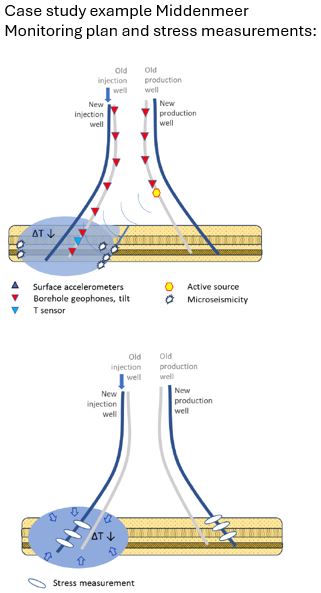3M Coldfront & induced seismicity
In this work package (WP4) we analyze how cooling of the deep subsurface (the ‘cold front’) resulting from geothermal heat production behaves in space and time. This is important for optimal geothermal production and to properly estimate the lifetime of a geothermal project. In this work package we also investigate how structures (e.g. faults) in the deep subsurface affect cooling, and vice versa, how the cooling affects the subsurface. The relationship between cooling and possible (micro)seismicity is investigated, in order to determine and properly underpin the permissible operational limits (injection temperatures and pressures) for optimal and safe geothermal heat production. This is done through an integrated approach of Monitoring, Measuring & Modelling – the 3Ms.
Field measurements and model studies will take place at three geothermal locations: Bleiswijk, Middenmeer and Kwintsheul and will allow us to better image the subsurface and validate existing models for cooling, reducing uncertainties in the model prediction. In addition, the sites will be instrumented with permanent monitoring equipment, to detect changes in temperatures and pressures, and the possible occurrence of (micro)seismicity. In some cases, monitoring will take place down to a depth of 2.3 km and close to the injection well – a unique and innovative opportunity to be able to directly measure cooling and its effects in the deep subsurface!
The expected results are:
– three (semi-)permanent monitoring facilities providing continuous recordings of the subsurface.
– public data for knowledge building and further analysis.
– models of the different geothermal projects, calibrated against the field measurements and monitoring data.
WP4 results will be useful for optimal and safe production for all geothermal projects in the Netherlands. Subsurface cooling processes can be better understood, and limits for safe and optimal geothermal production can be re-evaluated. Depending on the outcomes, this may allow higher pressures and lower temperatures during reinjection, leading to higher productivity of geothermal doublets.
WP4 research consists of several tasks:
- Monitoring the cold front
Installation of sensors for measuring pressures, temperatures and microseismicity in deep geothermal wells and at the earth’s surface at Middenmeer, Bleiswijk en Kwintsheul.
Comparison of the response of geothermal reservoirs (seismic, pulse test, etc.). - Measuring cooling effects on the subsurface
Measurement of cooling before production and during injection.
Stress test at Middenmeer and Bleijswijk.
Measurement of the velocity model at Kwintsheul. - Modeling and data processing
Calibration of subsurface parameters and subsurface processes (flow, cooling and possible induced micro-seismicity).
Site-specific 3D models & datasets – publicly available.
Partners – TNO, TU Delft, Ennatuurlijk Aardwarmte, GAIA Energy, Nature’s Heat, EBN, WEP

